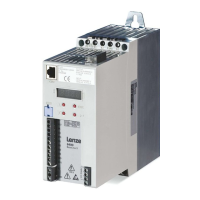5 Motor control (MCTRL)
5.7 Braking operation/braking energy management
102
Lenze · 8400 BaseLine C · Reference manual · DMS 1.6 EN · 01/2014 · TD05
_ _ _ _ _ _ _ _ _ _ _ _ _ _ _ _ _ _ _ _ _ _ _ _ _ _ _ _ _ _ _ _ _ _ _ _ _ _ _ _ _ _ _ _ _ _ _ _ _ _ _ _ _ _ _ _ _ _ _ _ _ _ _ _
5.7.1 Setting the voltage source for braking operation
The voltage threshold for braking operation is set via the mains voltage (C173) and the reduced bra-
ke chopper threshold (C174
. When this "brake chopper threshold" is exceeded in the DC bus, the en-
ergy is dissipated in the DC bus via the brake resistor and the DC-bus voltage is reduced.
• The brake chopper threshold is preset as follows so that it is higher than the specified mains
(C173
):
• This brake chopper threshold can be reduced by 0 ... 150 V via C174
.
Example:
• A 400 V device has a maximum mains voltage of 420 V AC.
• Maximum stationary DC-bus voltage: 420 V AC * 1.414 = 594 V DC
• C173
has been set with the selection "0" for 400 V AC mains.
• This means that C174
can be set to a maximum of 131 V DC (725 V DC - 594 V DC).
5.7.2 Avoiding thermal overload of the brake resistor
• Parameterisation of an error response in C574 and evaluation of the parameterised error mes-
sage within the application or within the machine control system.
• See chapter entitled "Brake resistor monitoring (I2xt)
". ( 106)
• External interconnection using the thermal contact on the brake resistor (e.g. supply interrupti-
on via the mains contactor and activation of the mechanical brakes).
Mains voltage Brake chopper threshold
C173 1-phase 3-phase 1-phase 3-phase
0 1ph 230V 3ph 400V 380V DC 725V DC
1 1ph 230V 3ph 440V 380V DC 35V DC
2 1ph 230V 3ph 480V 380V DC 775V DC
3 1ph 230V 3ph 500V 380V DC 790V DC
Stop!
The brake chopper threshold resulting from C173 and C174 must not exceed the statio-
nary DC-bus voltage!

